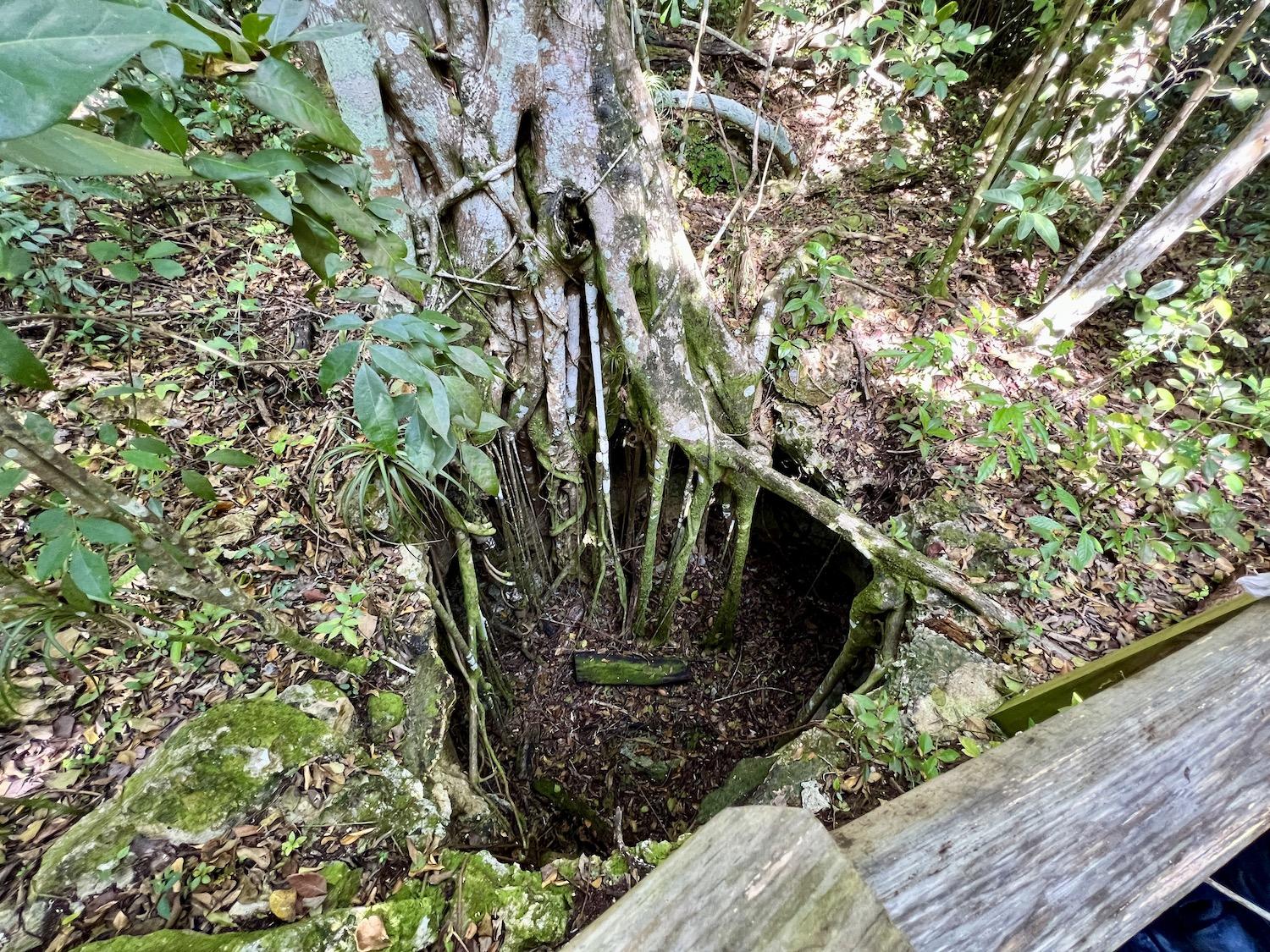
There are an estimated 19 sinkholes per acre in Primeval Forest National Park/Jennifer Bain
Stepping into Primeval Forest National Park is like entering a time capsule and being transported back to when the Bahamas was covered with tropical forests. Agriculture, the lumber industry and shipbuilding wiped out great tracts of trees, but not these 7.5 acres on New Providence island. “Sprouting from razor-sharp rock and dotted with sinkholes, the forest proved too difficult to traverse and impossible to farm,” interpretive signage explains. “Thus it escaped the ravages of agriculture and development.”
Kristoff Francois is showing me around the old-growth woodland that represents the early evergreen tropical hardwood forests of the Bahamas. He was the park warden here for eight years but now he’s a university student studying to be a botanist, and today he’s a park volunteer with his 4-year-old daughter Kristia in tow.
Kristia wants to see Bahamian boas, which do live here and can also be spotted in the trees. I want to see sinkholes. Unfortunately only one of us will get our wish.

Kristoff Francois leads a tour of Primeval Forest National Park with daughter Kristia in tow/Jennifer Bain
“There are 19 sinkholes per acre here,” Francois announces to start our private tour and I realize that means I'm surrounded by 142.5 of them, give or take.
I stop counting after the first three and just admire them. The largest sinkholes here are 50 feet long, 30 feet wide and 30 feet deep, but most are modest. Apparently these interconnected holes and caves form an underground labyrinth, but visitors are warned to stay on the trails and so that's not part of the experience.
People call this unsung park — established in 2002 — a “geologic treasure,” and yet barely 5,000 visitors (mostly school groups) make their way here each year. “I think the issue that we’ve had here is we haven’t really advertised the way that it should be, and so people hear about it accidently and they come out,” Francois laments. “I think with proper advertising, this place could be one of the best natural spaces on the island.”
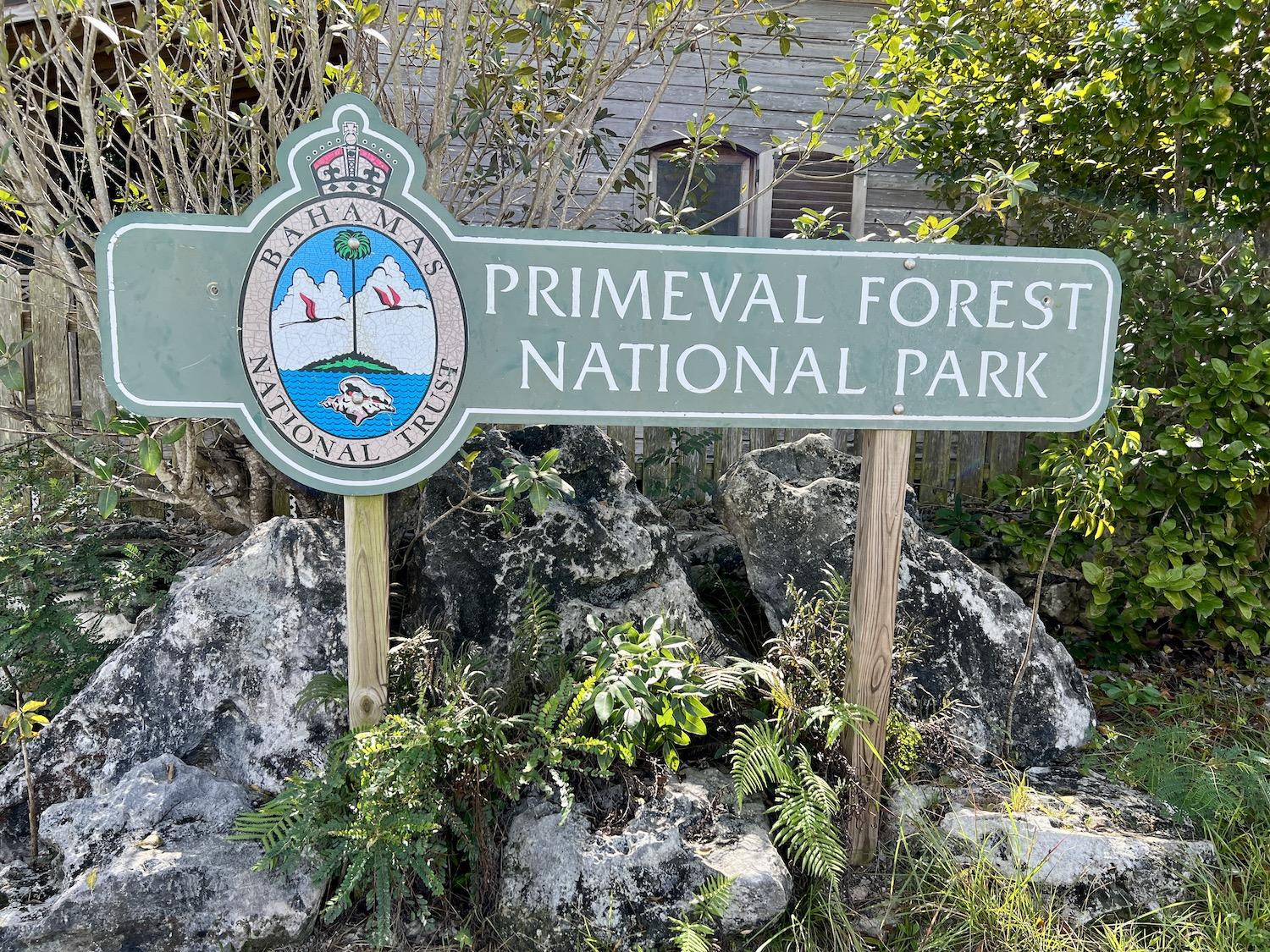
Primeval Forest National Park is an easy drive, or cab ride, from downtown Nassau/Jennifer Bain
As we talk on a Saturday morning in January, two tourist groups pull up unexpectedly, pay their entrance fees and guide themselves through the park. This feels like a good omen.
Like me, they will read how this karst landscape boasts highly dissolved and eroded remnants of limestone rock. When sea levels fell thousands of years ago, rainwater rapidly dissolved the exposed limestone. Water drained through the cracks, widening them to form "solution holes." An underground drainage system developed, allowing more water to pass. Solution holes deepened and became banana holes, blue holes and today’s caves.
Walking the 1/4-mile trail at a leisurely pace, I learn that Francois is a local who played in these sinkholes and forests as a kid and slowly got to know the area's plants, animals, trees and stories. He counts Pericles Maillis as his mentor. The lawyer/conservationist led the charge to preserve this rare, undisturbed forest tract and bring it under the care of the Bahamas National Trust (BNT), where he served as as president.
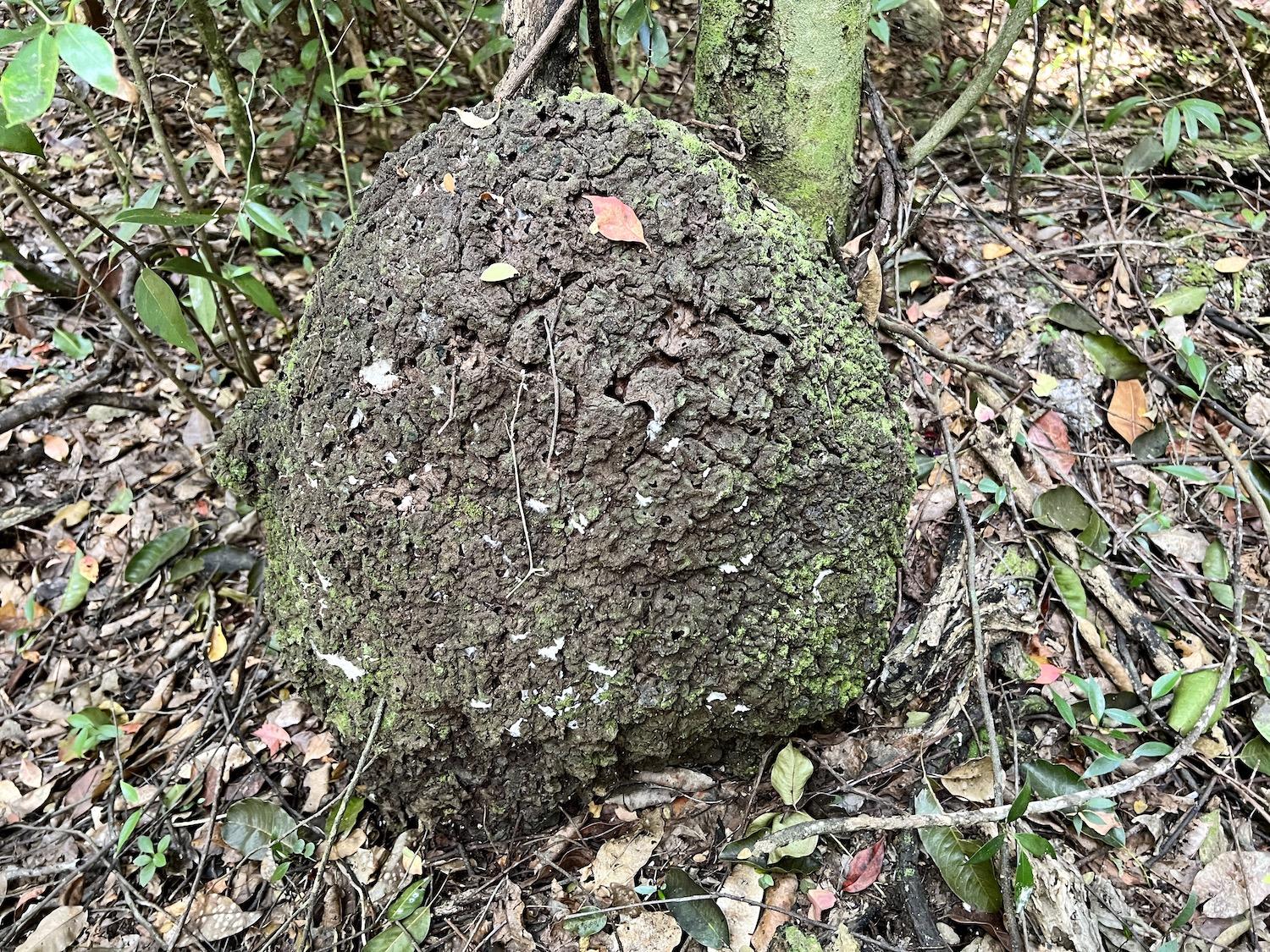
Termite mounds were once used by Bahamians to feed chicks/Jennifer Bain
The BNT says its recognized that the forest and karst features represented both one of the island's last remaining blackland coppice stands, and "an exceptional example of the unique geology of the Bahamas." Now a looped path with boardwalks, steps and bridges guide people through the park, past a geology platform, a couple of caves (grottos) and the Great Mahogany Tree.
In front of a rather massive termite mound, I hear how Bahamians onced carved out chunks of the protein-rich nests to feed to their chicks. In the Marine Fossil Grotto, I check out a fossilized conch shell and read up on the ancient burrowing shrimp-like creatures that lived here more than 125,000 years ago when it was a shallow lagoon. Now there are fossilized burrows called Ophiomorpha that look like large soda straws.
I spend a few minutes admiring the West Indian mahogany tree that's reportedly the largest of its kind in the wild on this island. "Dating back to colonial times, this ancient giant has a long and vivid memory," signage explains. "It holds climate and other historic records safely locked within the patterns of its growth rings."
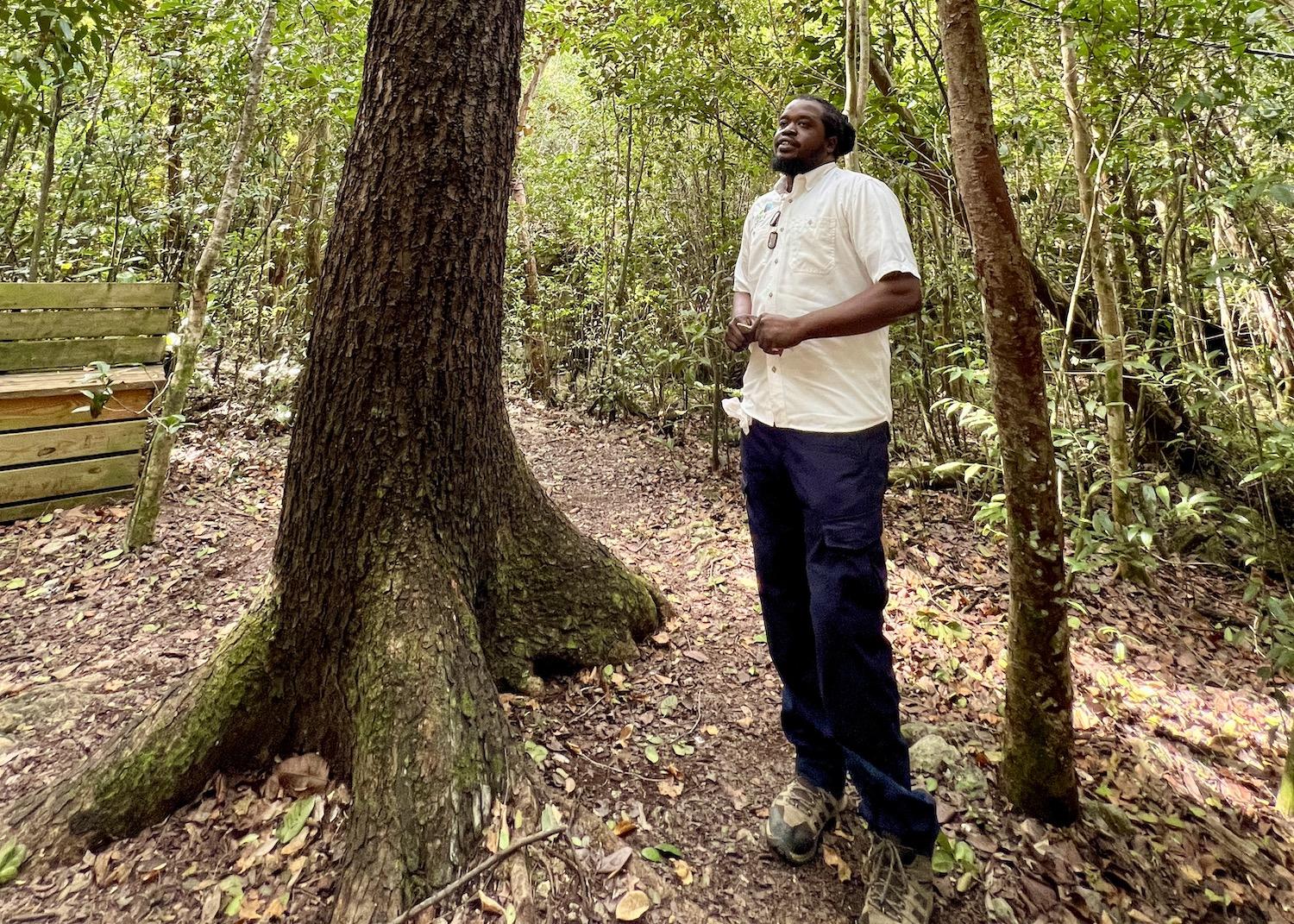
Kristoff Francois stands by the oldest West Indian mahogany tree on New Providence/Jennifer Bain
The hope, Francois says, is to get a modest 50 visitors a day “to meet our quota but also not have an adverse effect on the environment.” Those numbers would bolster the need for an expanded trail system that would create less wear and tear on the park. “You want people to enjoy a park," Francois says, "but you also want to ensure it is conducive to the mandate of managing them properly and ensuring the species are properly protected."
Back at the visitor center, I’m about to lament about the graffiti etched into the shiny, leathery leaves of a pitch apple tree. Francois jumps in to say that when Spaniards first came to these islands several hundred years ago, they weren’t allowed to gamble aboard their ships and so they carved playing card into leaves to gamble behind their captains’ backs. Later, as the population grew, people used leaves to send messages between communities.
“In remembrance of those times, we allow folks to sign the leaf of a specific tree," he says. "That’s why it’s referred to as the autograph tree or signature tree."
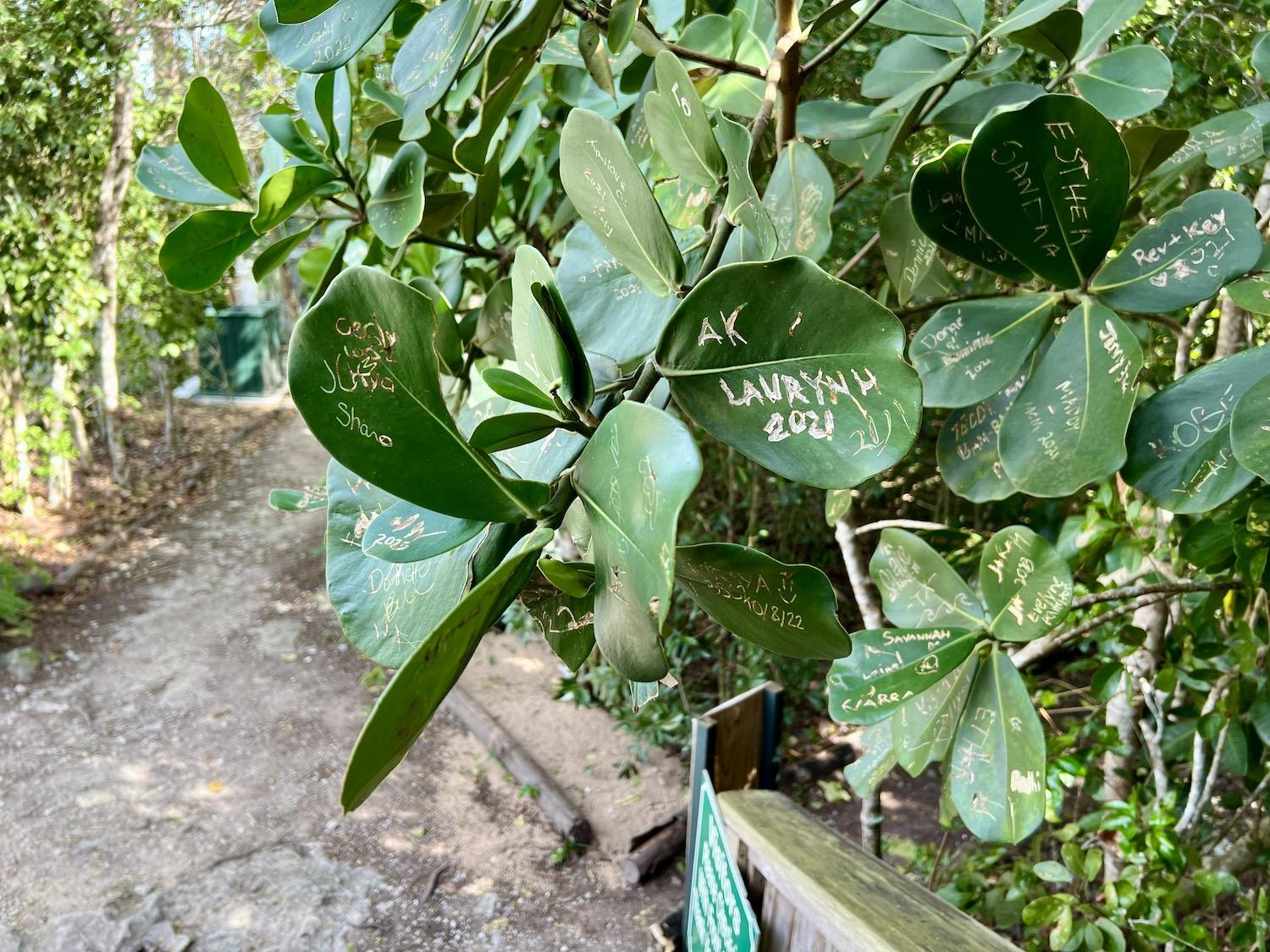
Primeval Forest National Park visitors are allowed to sign the autograph tree/Jennifer Bain
It doesn’t take long to explore Primeval Forest. I do it in a leisurely hour with Francois, but those without guides motor through it in half that time. The park is only open Fridays, Saturdays and public holidays at the moment. The same goes for Bonefish Pond National Park. I explore them both while waiting for a connecting flight in Nassau between Freeport and Toronto. After all, New Providence is just 21 miles long and 7 miles wide and so easy to devote what little time I have here to nature.
Although it’s considered part of the Caribbean, the archipelago that makes up the Bahamas actually lies in the Atlantic, 50 miles off the eastern coast of Florida. Only 16 of its estimated 700 islands are used for tourism and more than 7 million people visited in 2022. New Providence is home to the bustling capital city of Nassau and a multitude of resorts (like Atlantis Paradise Island), but also four little-known national parks including Primeval Forest in the west and Bonefish Pond in the south.
Added to the national park system in 2002, Bonefish Pond protects about 1,250 acres of coastal wetlands with a small amount of “hardlands.” Unless you’ve got a kayak to explore the mangroves or are keen to tackle the fast-moving tidal creek and swim or snorkel at your own risk, you’re probably just headed to the 600-foot boardwalk.
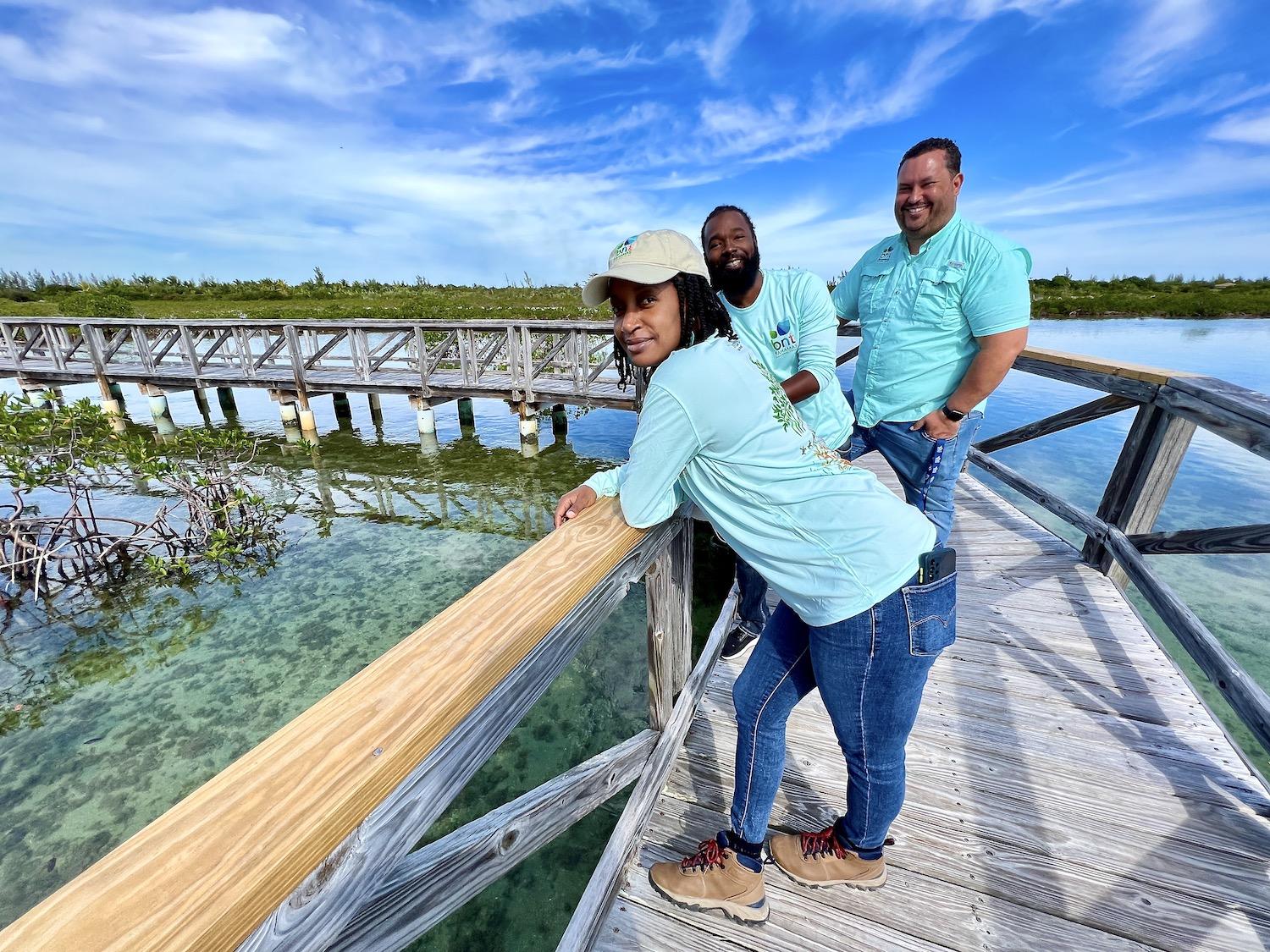
The Bahamas National Trust team of Chantal Curtis, Audie Morley and Lindy Knowles are shown at Bonefish Pond National Park/Jennifer Bain
I stroll with park warden Audie Morley, New Providence parks manager Chantal Curtis and senior science officer Lindy Knowles. They tell me that wetlands like this were long considered wastelands and used by the community as informal dumping grounds. More than a dozen years ago, it took an excavator to remove the mountains of trash that once went from the water’s edge to the road. The problem hasn't been fully resolved. As recently as five years ago, a kitchen sink was found by snorkelers.
These mangrove creeks, seagrass meadows and sandy shores are critical habitats for fish and invertebrates like groupers, snappers, grunts, bonefish, barracuda, crawfish and queen conch. Although the park takes its name from a slender, silvery and elusive fish that’s a big tourism draw with anglers, the bonefish is rarely seen here.
There’s no entrance fee, and only about two per cent of the park is used. It's a popular “learning environment” though and draws up to 10,000 students a year. Today there are several people preparing to enter the water to study water quality. There are dreams of a visitor center, expanded boardwalk and trails to get more people into the park without adversely affecting the fragile reefs.
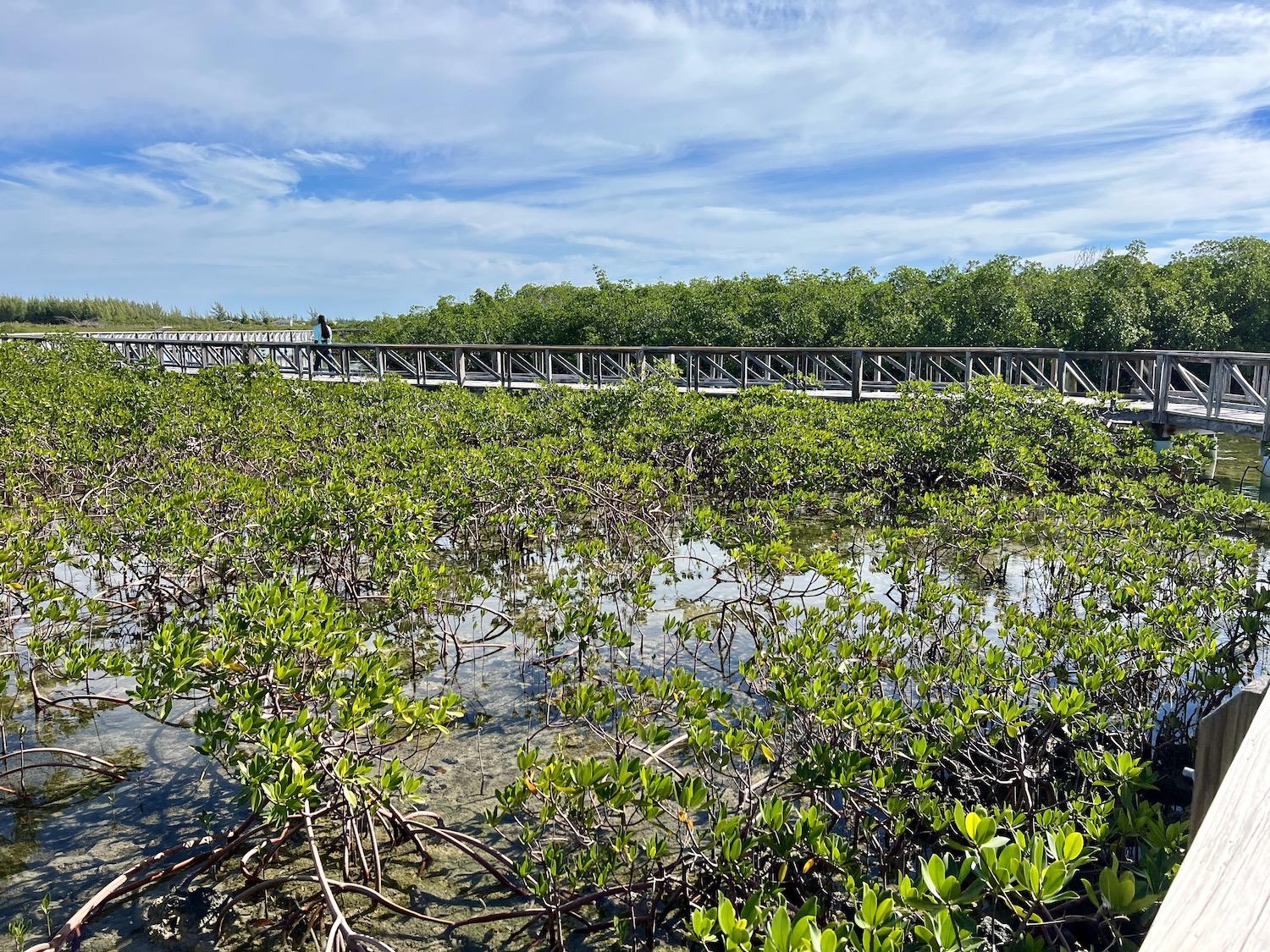
A short boardwalk lets visitors explore Bonefish Pond National Park's mangroves and tidal creek/Jennifer Bain
“We’re very climate vulnerable because the lands that surround us are all private land and farm land, so the ability of our mangroves to retreat has been limited by those barricades,” Knowles points out.
The water is so shallow and clear that it almost feels like we’re snorkelling from the boardwalk as marvel over a sea cucumber, lesser star coral and everything from yellowfin mojarra, gray snapper and Sergeant majors to parrotfish, a sponge and spiny lobster.
“We will see barracuda, guaranteed,” promises Knowles.
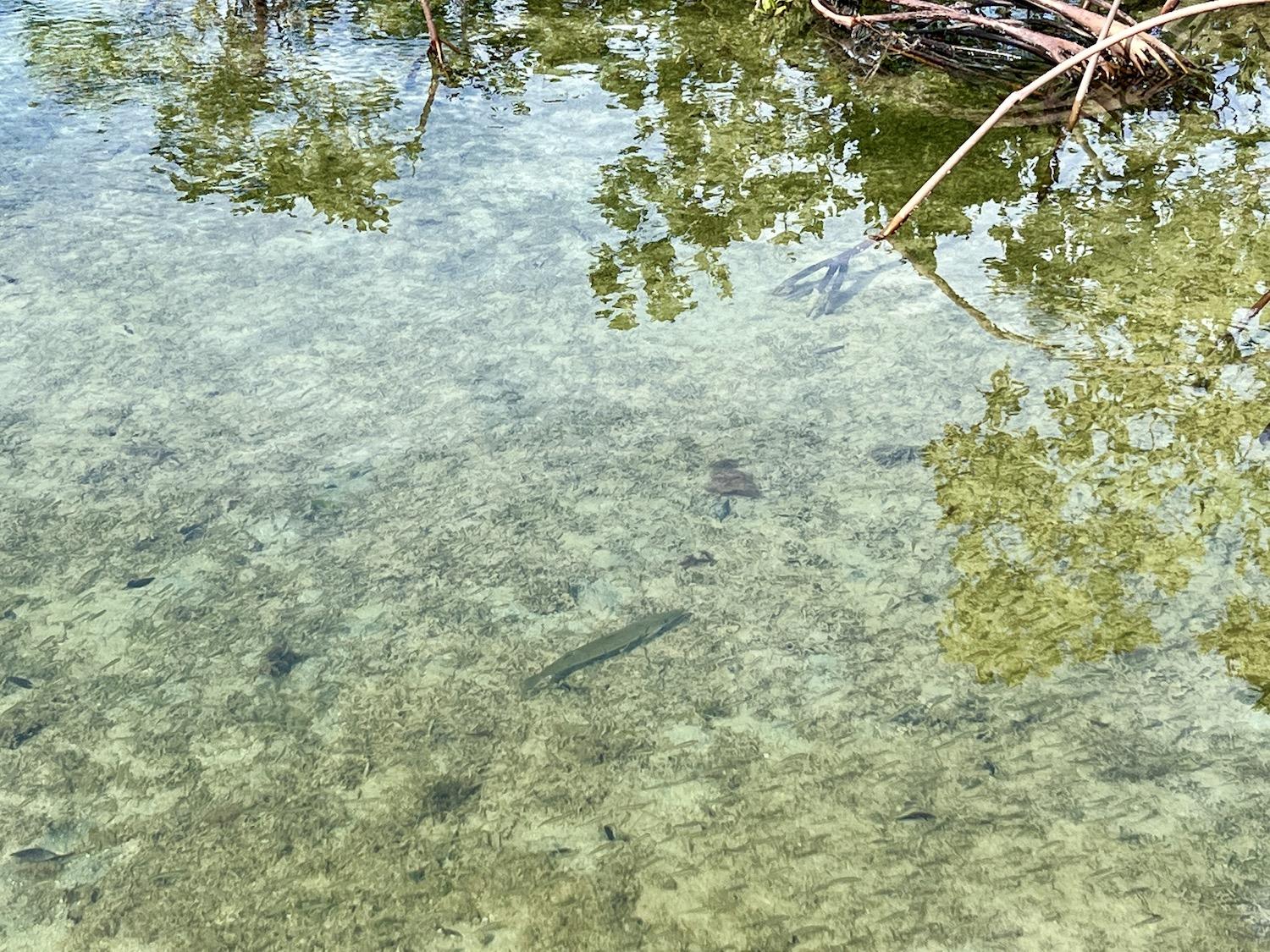
A young barracuda waits for prey in Bonefish Pond National Park/Jennifer Bain
It’s not until we’re headed back to our cars that a sudden flurry of activity proves him right. “See a camouflaged barracuda right there,” says a triumphant Knowles. “So he was just lined up with the current waiting for hopefully another leaf with a crab to come by.”
We’re temporarily distracted by a spotted puffer fish — like Mrs. Puff from the animated SpongeBob SquarePants series, but with red eyes — until we hear several rapid splashes and spot two young barracudas trying to get themselves meals.
After my quick visits to Primeval Forest and Bonefish Pond there isn't time for the island's other two national parks — Harrold & Wilson Ponds National Park and the Retreat Garden. Instead I call a cab to downtown Nassau’s crowded fish fry area for a takeout lunch before my flight. I'm not in the mood to eat fish today, so load up on sweet, fried plantains, tangy coleslaw and comforting Bahamian-style rice and peas, and then chat with friendly cab driver Santina Deveaux about what a joy it has been to spend a brief layover in two of her island's tranquil but underappreciated parks.
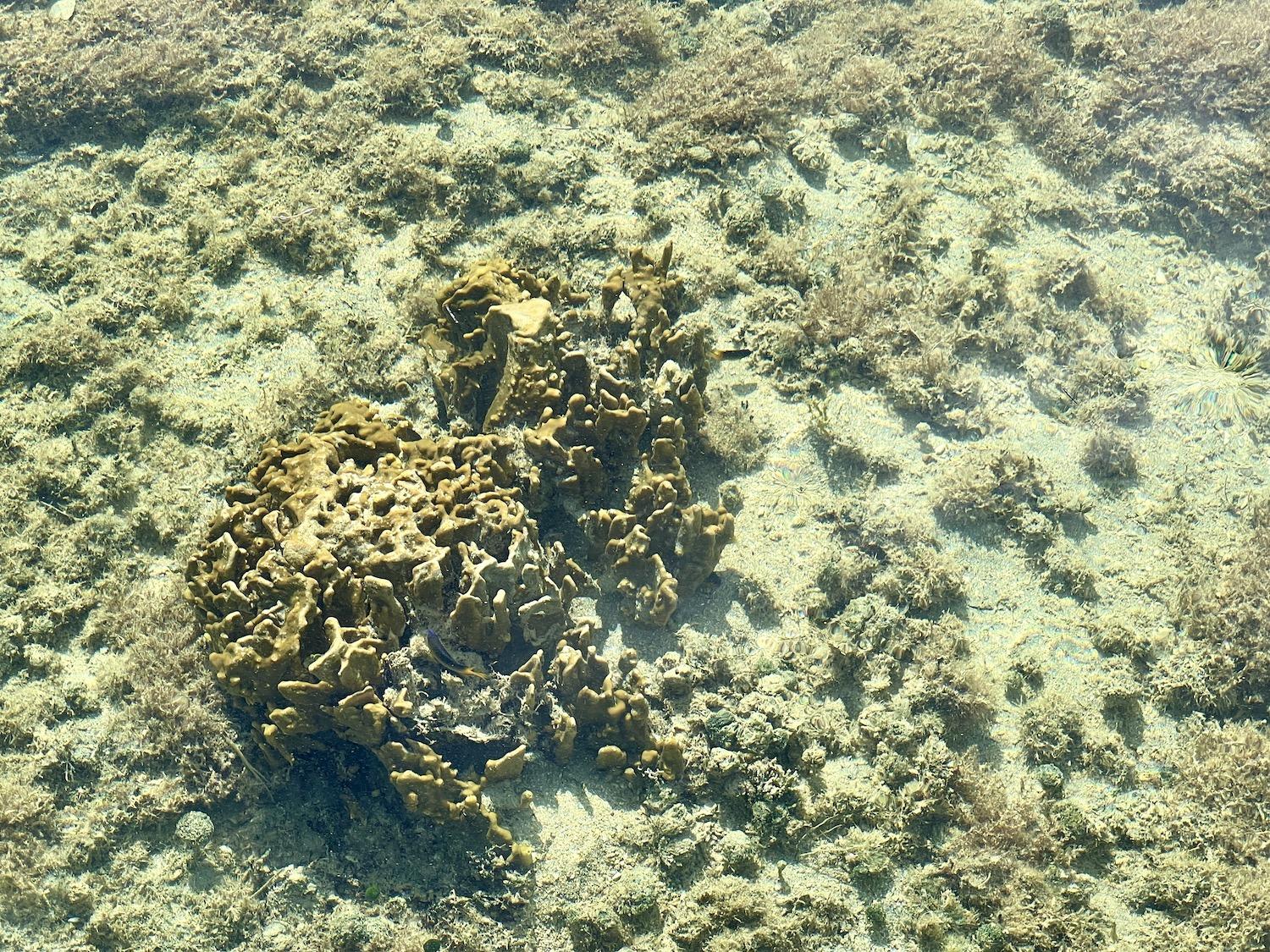
You can see lesser star coral in the clear, shallow water at Bonefish Pond National Park/Jennifer Bain


